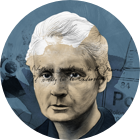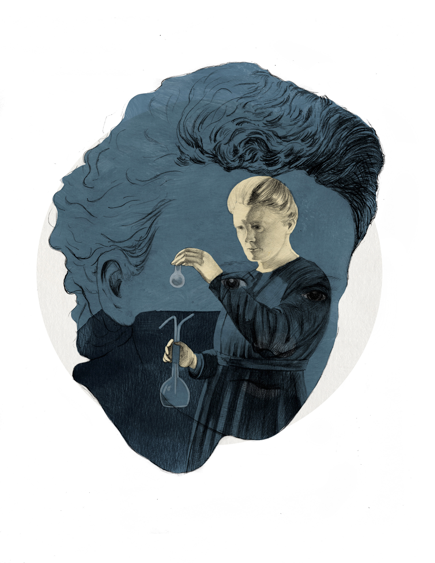
PORTRAIT OF A LEADER
Marie Curie
The Theoretical Leader
Marie Curie (1867 – 1934) was the towering scientist of her day. She was born in Poland, educated in France, and was the first woman recipient of two Nobel Prizes (in physics and chemistry). She was brilliant, persistent, and courageous in her pursuits. She is heralded as the most famous female scientist of all time, and has also been awarded many posthumous honors. Together with her husband Pierre Curie, they discovered polonium and radium, and their works led to the further refinement of X-rays. Educational institutions and medical research centers bear her name, including the Pierre and Marie Curie University and the Institute Curie. Marie Curie is a formidable example of the Architect Rational INTP. She shares the same temperament type as Albert Einstein, and we call her the Theoretical Leader.

Theoretical Leaders lead by their expertise and thought leadership.
She became a Theoretical Leader, not because she sought to be one, but because she had such a pure love for science. She did it for the “the beauty of science,” believing that “there is always the chance that a scientific discovery may become… a benefit for mankind.” During a time where women were not allowed to speak in many forums, she broke through to clearly establish herself as a leader. Many scientists found it hard to believe that a woman could be the originator of such important discoveries and the formulator of key theoretical works in her field. Marie Curie was the first woman to become a professor at the University of Paris. She was the first woman to win a Nobel Prize, and the first person and only woman to be awarded the prize twice (in multiple sciences). Her expertise and thought leadership positioned her to start the world’s first studies for the treatment of neoplasms using radioactive isotopes. She was the originator of the theory of radioactivity, and discovered two elements, polonium and radium. She founded major medical research centers, radiological centres, and mentored four Nobel Prize winners, which included her daughter Irène Joliot-Curie and her son-in-law, Frédéric Joliot-Curie. Marie Curie caught the attention of the entire scientific world.
Theoretical Leaders can see the underlying complexities of seemingly simple truths.
Theoretical Leaders will question ancient assumptions, believing that assumptions can often be barriers to breakthroughs. Marie Curie hypothesized that radiation was not the outcome of interactions between molecules, but came from the atom itself. This was an important step in disproving that atoms were indivisible. Her ability to see complexity the way she did allowed her and her husband to publish 32 scientific papers. Her experiments enabled her to make the claim that diseased tumor-forming cells were destroyed faster than healthy ones when exposed to radium. She was able to connect her findings between radiology, anatomy, and automotive mechanics to procure X-ray machines, vehicles, and generators. As she conducted her experiments, she knew that discoveries in her laboratory had far reaching implications for the future of humankind. She believed that the scientist could discover breakthrough ideas if they remained curious and excited about their work. She said, “A scientist in his laboratory is not a mere technician: he is also a child confronting natural phenomena that impress him as though they were fairy tales.”
Theoretical Leaders are open to ideas that they deem to be useful regardless of the idea’s origin.
Theoretical Leaders gather ideas, and partner with anyone who will advance their cause. They start from any place where opportunity can be found. Marie started her career by investigating magnetic properties of various steels. She was introduced that same year to Pierre Curie who also had an interest in the natural sciences. She used an invention built by her husband called the electrometer to discover that uranium rays caused the surrounding air to conduct electricity. She was utilitarian in using whatever resources were available, including people to further her work. She intentionally refrained from making any claims on the radium-isolation process, so that the scientific community could do research without any encumbrances. She believed, “Nothing in life is to be feared, it is only to be understood. Now is the time to understand more, so that we may fear less.” This belief caused her to work with many to reach collective breakthroughs. She believed in building a better world, and by doing it with others. She said, “You cannot hope to build a better world without improving the individuals. To that end each of us must work for his own improvement, and at the same time share a general responsibility for all humanity, our particular duty being to aid those to whom we think we can be most useful.” Marie was an impactful leader because she cared about the mission over her career.
Theoretical Leaders naturally probe for assumptions, implications, and relevance when presented with different hypotheses.
Marie Curie was always reading books, corresponding with colleagues, while mentoring, and being mentored. She was a lifelong-learner, continually educating herself. She was influenced by others in her field like Wilhelm Roentgen who discovered the existence of X-rays, and Henri Becquerel who demonstrated that radiation seemed to arise spontaneously from uranium directly. As a result, Marie looked into uranium rays to do further research, and came up with her own hypotheses. She was able to see what was relevant, what assumptions were in play, and what the implications were for her pursuits. She was persistent, and displayed extraordinary willpower, and it resulted in the overturning of many established ideas in physics and chemistry during her time. This led to profound effects on society. Marie moved methodically, but without hesitation, carefully, but with confidence. Rather than settling for taking the typical role of a critic within the scientific community, she forged ahead to make discoveries. She said, “There are sadistic scientists who hurry to hunt down errors instead of establishing the truth.” She knew full well that her exploration would take a lifetime. She stated, “I was taught that the way of progress was neither swift nor easy.”
Theoretical Leaders have the patience to “stick it out” when dealing with complex problems.
Laboratories were built for her by the notable Pasteur Institute and the University of Paris. This is in such stark contrast to her humble beginnings. Marie delayed her enrollment at the University of Paris because she could not afford the tuition. To make everything work, she stayed with her sister and brother-in-law, and then rented a small place using her meager resources. She suffered through cold and bitter winters, and occasionally fainted due to hunger. She studied during the day, and tutored at night to make ends meet. She got by with the aid of fellowships. She conducted much of her research out of a poorly ventilated shed next to her school that was not even waterproofed. At the time, the school did not sponsor her research, so she sought subsidies from various companies, organizations, and governments. The Curies conducted experiments that were not attempted in her day, requiring precision, and patience, at the detriment of their own health. They declined to go to Stockholm to receive their Nobel Prize in person because they were too busy working. Many sought to suppress her achievements because she was a woman. To achieve, she had to overcome. She said, “Life is not easy for any of us. But what of that? We must have perseverance and above all confidence in ourselves. We must believe that we are gifted for something and that this thing must be attained.” When asked about her career as a woman, she said, “I have frequently been questioned, especially by women, of how I could reconcile family life with a scientific career. Well, it has not been easy.”
